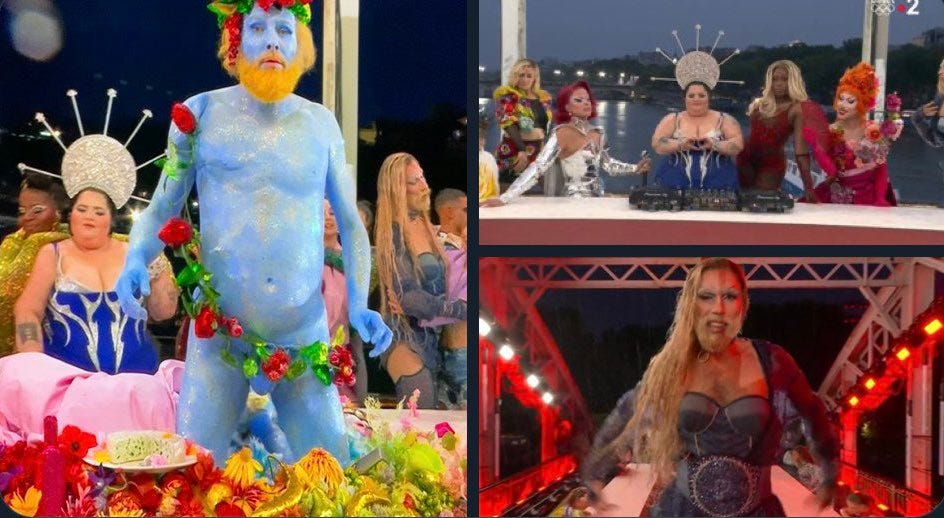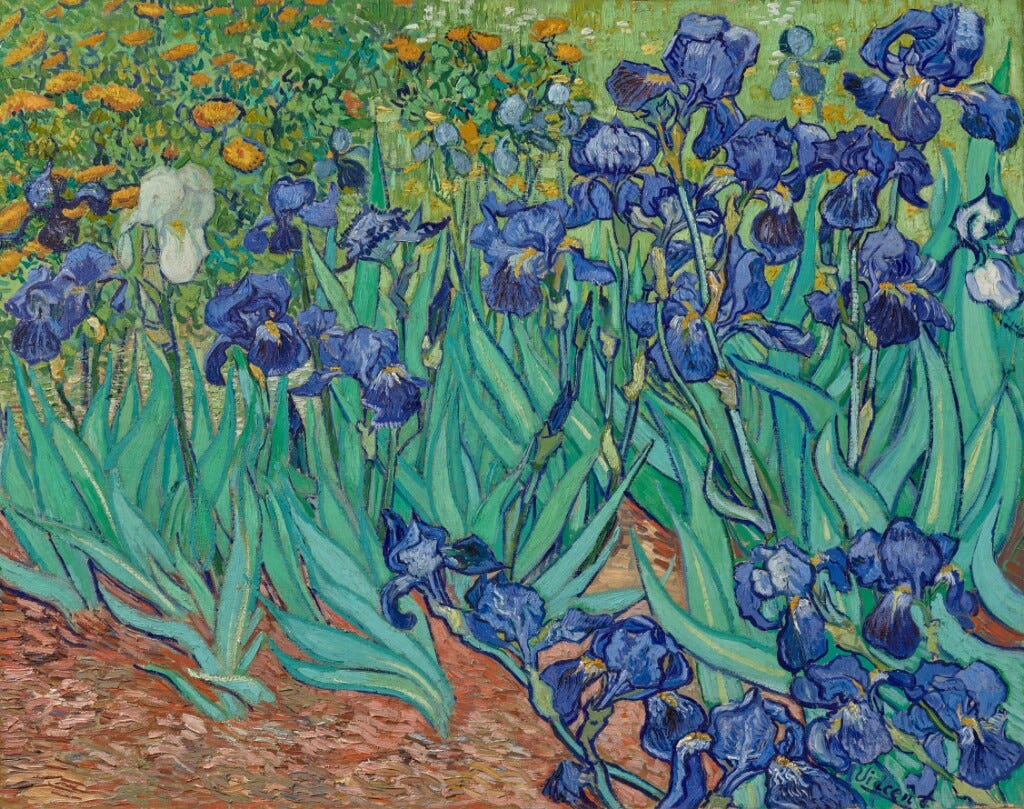
The abomination you see here, and Disney Star Wars, and all of modern Hollywood, and all of Manhattan tradpub, can be explained with one simple idea.
And no, it isn't "Satan."
Yes, the images above were intended to mock Da Vinci’s “Last Supper”, but no supernatural suppositions are required to explain the impulse behind it. What's going on here is venial, and even more depraved.
Narcissism.
You see, there are two kinds of artistic creativity. Both are based on egotism, but one is healthy, and the other is destructive. The first says:
"Art is about beauty and truth. I will create that which is beautiful and true, that which uplifts those who look upon it. And my ego will be satisfied when my work is acknowledged as good, both by myself and others."
This is based on a healthy version of egotism... pride. Pride is self-respect, a sense of one's own proper dignity or value, as earned through merit, virtue, and accomplishment. The second says:
"Art is about self-expression. I will create art based on whatever is in myself, no matter how ugly, deceptive, and low. I will make myself visible in every aspect of my art, and my ego will satisfied, because I will be the center of attention, with everyone looking at me."
This is based on the sick version of egotism... narcissism. It is the ego that demands to be the center of attention, regardless of what others actually wish to see or would like to pay attention to. It is the revenge of the neglected child, not on the mother who ignored him, but on the entire universe.
Great art is not about self-expression. It comes from the self, it is shaped by the self, it is often dredged from the deepest recesses of an artist’s soul, but the truth it expresses is shared and universal. This is why it speaks to others, not just the artist.
When we look upon a fine sculpture, we see only David, not Michelangelo.
When we read a great story, we do not see Tolkien, and we forget, for a moment, that Frodo and Sam aren't real.
We can say Van Gogh painted one white iris because he was lonely, isolated within a crowd, but if we do say that, we care because we have been lonely, too.

Great art makes the artist invisible. He waits backstage until the art is done, and it is time for him to step out and take a bow, receive his applause and be satisfied in a work well done. He does not stand between the audience and their enjoyment of the work.
But, for this precise reason, great art cannot emerge from narcissism. The narcissist cannot bear to upstaged by anything, even the work of his own hands, the child of his own brain. The narcissistic artist creates art not to please others, but to force others to look at him. He must stamp his personality on every corner of the work, make it his and his alone, and remind the audience, in every moment, in every place they direct their gaze, that this work is his, and that he is what truly matters, here.
This art, shown here, is not ugly by accident. It is ugly because the artists wish you to look upon their ugliness, both outer and inner. It is ugly because its message is not "look at this" but "look at me."
Narcissistic art flows from the belief that the purpose of art is self-expression. The narcissist simply creates something that flows from who he is, out of this desperate desire to be beheld, understood, and admired by the world. Since the purpose of his art is to show himself, there's no right or wrong way to do it, no objective or even external standard he can be held to. He can do anything. He can rewrite the canon of Star Wars so all the characters look and act like him , and express his desires and feelings. He can retcon a George Floyd clone into feudal Japan. He can spatter paint on a canvas at random. He can tape a banana to the wall. He can tell you a story about how Cleopatra was a black woman.
This is why the left is obsessed with "representation" in art. This is why they cover themselves in ugly, mismatched tattoos, and dye their hair pink, purple, and blue. This is why they write self-indulgent stories about "identity" and "finding your squad." They are screaming their identity at the void, never realizing that it's not only possible, but easy, to be unique without being interesting or useful.
This art holds itself to no standard. It is a child's tantrum, thrown by an adult on a stage visible to the world. It is a demand to be witnessed by the world, not for accomplishment or merit or virtue, but for mere selfhood.
Those who fancy themselves to be beautiful unique snowflakes would do well to remember that the slightest touch of heat will turn them into homogeneous, ubiquitous, undifferentiated water. They can work for Disney all they want, making black lesbian Jedi so that "the character can look just like me," but the character will be boring because they are boring. In other words, what we are seeing here is not a rebellion against god (if you are religious) or civilization and merit (if you aren't), it's something far worse. It's the petty, ugly, banalities of an entire subculture of tiresome neurotics who cannot dredge one single beautiful, interesting, or true thing out of their souls that would make you voluntarily pay attention.
The question, of course, is why. Why this demand to be known, and seen, to put on a display that demands judgement yet recoils at it?
It is a demand for unconditional love. Love which the narcissist, deeper in their hearts, fear they are incapable of earning even at their best. So they throw out their worst, and demand praise, unconditionally—for if you can love them at their worst, it does not matter what their best may be, and they need not fear their cowardice and inability to strive for it.
But unconditional love is for infants only. An infant must be able to receive love without doing anything, because an infant needs care, but can do nothing. So mothers are biologically programmed to love infants... unconditionally. A healthy child grows, and improves, and learns to do things, and the end result is an adult who is fully capable not only of acting to inspire love, but of figuring out how to do that.
Adult love, and admiration, is conditional, always. No one would, or should, love you if you are a worm. Mere existence is not enough for admiration.
Art which flows from self-respect, from the knowledge that respect exists and is possible to earn, holds itself, and the artist, to an external standard. Self-expression is present in this art, too, but it is simply an unavoidable side effect of pursuing the art's true purpose: to have a positive effect upon the audience.
It may teach something, it may show a vision of beauty to please the eye, ear, or mind, it may inspire the audience to be better than they were yesterday. It may open up unconsidered possibilities, or provide a temporary respite from the daily stresses of life. It may make you laugh, or cry, or think, or all of these. It may simply entertain. But it is there for audience, not the artist alone. And it can be judged, it can succeed or fail, based on how well it serves that audience.
Unearned applause is the entire goal of the narcissist, but it is torture for the healthy artist.
The prideful artist wishes to love himself, but he wishes to achieve this self-love conditionally, by pursuing this external standard, and achieving it, and knowing that he is worthy. Unearned applause is the entire goal of the narcissist, but it is torture for the healthy artist. He must know that he has been found good according to a measuring stick that exists independently of him.
Art that cannot be held to an external standard, that does not seek to be held to one, is nothing but slop, homogeneous goo, or which no unappetizing spoonful can be more tasty or satisfying than any other.
It is the soylent green of the soul.
Because it is made out of people.
I write science fiction novels. I just started doing this... my first, Theft of Fire, published less than a year ago, and the second is only half complete. I have a lot to learn. And yes, when I write, I create my characters out of pieces of myself, and others. But I select those pieces to be pieces of you, too, so that I can hope that they will speak to all of us. Yes, all of our media companies, all of our art institutions have been infiltrated by Gay Race Communists and their toxic narcissism. They use them to publish endless self-portraits of their ugliness, and to demand that we applaud that ugliness, unconditionally, and call us racists and sexists and bigots when we don't.
But there is an alternative. Art doesn’t come out of institutions. You don't need an institution to create art. You can just... do it.
And you can find others who have done so, and enjoy their work. I hope I've done a good job, but that's not up to me.
I'm not the external standard.
You are.
Devon Eriksen is author of the novel Theft of Fire: Orbital Space #1. Learn more about the author, read sample chapters, and find retailers on his website DevonEriksen.com, or get it on Amazon today.
Find more of Eriksen’s thoughts on X: @Devon_Eriksen_





Devon is new to Substack, so I hope everyone who enjoys his writing on Twitter can give him a warm welcome to the platform, by "restacking" this post!
I had an art course when I was in college where they talked about art as a medium to communicate ideas. While it was inevitable that that idea would be filtered through both the artist's expression of the idea and the viewer's interpretation, still the idea got through. But that theory stuck with me, and I formulated a saying: "I've long held that if a piece of art requires a little plaque next to it to tell you what it actually means, then it has failed. And if the artist says "It means whatever you want it to mean" then the artist has failed."
And when engaging with leftists who excuse all things as art, and therefore good, rather than quibble over whether signing a fake name to a urinal is art, it's better to argue that not all art is good. There can be Bad Art. And it certainly does not all merit public funding.